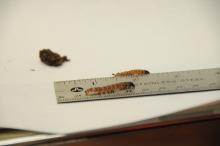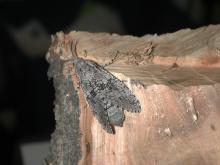Prionoxystus robiniae
Pest description and damage The caterpillars are white to pinkish red with a dark head and are 1 to 3 inches in length when mature. They bore in the trunk and main branches of multiple host trees. Discolored or bleeding limbs, branch dieback, and lumpy or gnarled trunks may be indications of carpenterworm infestation. Look for sawdust-like material (frass) and wood chips mixed with loose webbing on or around the surface of infested trees. Trees or branches with severe carpenterworm infestations are susceptible to wind breakage and may need to be removed if they pose a safety hazard. The adult moths are 1.75 to 3.0 inches in length and mottled gray and black in color.
For biology, life history, monitoring and management
See:
Cottonwood (Populus)-Carpenterworm
Management-chemical control
See Table 4 in:



